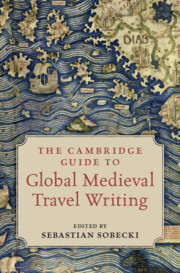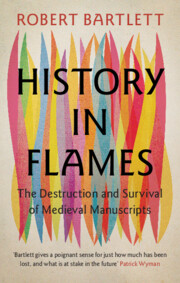Refine search
Actions for selected content:
86 results
Eighth Collection
- from Letters for the Advancement of Humanity
-
- Book:
- Johann Gottfried Herder: Letters for the Advancement of Humanity
- Published online:
- 13 December 2025
- Print publication:
- 22 January 2026, pp 377-431
-
- Chapter
- Export citation
Seventh Collection
- from Letters for the Advancement of Humanity
-
- Book:
- Johann Gottfried Herder: Letters for the Advancement of Humanity
- Published online:
- 13 December 2025
- Print publication:
- 22 January 2026, pp 325-376
-
- Chapter
- Export citation
1 - History
-
- Book:
- Making Medical Progress
- Published online:
- 12 December 2025
- Print publication:
- 20 November 2025, pp 34-65
-
- Chapter
-
- You have access
- Open access
- HTML
- Export citation

The Cambridge Guide to Global Medieval Travel Writing
-
- Published online:
- 03 October 2025
- Print publication:
- 02 October 2025
Introduction - Towards a Global History of Medieval Travel Writing
-
-
- Book:
- The Cambridge Guide to Global Medieval Travel Writing
- Published online:
- 03 October 2025
- Print publication:
- 02 October 2025, pp 1-18
-
- Chapter
- Export citation
Gender Bias in Medieval Inquisitions and its Place in Shaping Knowledge about the Heterodox
-
- Journal:
- Social Science History , First View
- Published online by Cambridge University Press:
- 26 August 2025, pp. 1-31
-
- Article
-
- You have access
- Open access
- HTML
- Export citation
Postface
-
- Book:
- Performing Justice in the Later Roman Empire
- Published online:
- 07 August 2025
- Print publication:
- 21 August 2025, pp 114-117
-
- Chapter
- Export citation
Introduction
-
-
- Book:
- The Cambridge Companion to Christian Heresy
- Published online:
- 17 July 2025
- Print publication:
- 31 July 2025, pp 1-14
-
- Chapter
- Export citation
1 - Europe’s Unchristianised Edge
-
- Book:
- Silence of the Gods
- Published online:
- 19 June 2025
- Print publication:
- 19 June 2025, pp 61-113
-
- Chapter
- Export citation
3 - Monarchia Universalis: From Ordering Principle to Threat of Order
- from Part II - Introduction: From Universal Monarchy to Territorial Balance of Power
-
- Book:
- Representants and International Orders
- Published online:
- 15 May 2025
- Print publication:
- 08 May 2025, pp 69-112
-
- Chapter
- Export citation
Chapter 10 - European Literature, Dante to Rousseau
- from Part II - Intellectual, Cultural, and Political Contexts
-
-
- Book:
- Percy Shelley in Context
- Published online:
- 17 April 2025
- Print publication:
- 24 April 2025, pp 74-81
-
- Chapter
- Export citation
Textual Layering, Landscape Memory, and Medieval Places in Vayots Dzor, Armenia
-
- Journal:
- European Journal of Archaeology / Volume 28 / Issue 3 / August 2025
- Published online by Cambridge University Press:
- 04 April 2025, pp. 369-390
-
- Article
-
- You have access
- Open access
- HTML
- Export citation
ALHAMAT: analysing materiality of the Alhambra to elucidate the Nasrid dynasty's power in the Emirate of Granada
- Part of
-
- Article
-
- You have access
- Open access
- HTML
- Export citation
1.1 - The Age of Devotion
- from History 1 - Movements
-
-
- Book:
- The New Cambridge History of Russian Literature
- Published online:
- 31 December 2024
- Print publication:
- 12 December 2024, pp 15-33
-
- Chapter
- Export citation

History in Flames
- The Destruction and Survival of Medieval Manuscripts
-
- Published online:
- 22 August 2024
- Print publication:
- 22 August 2024
Chapter 2 - Libraries and Archives
-
- Book:
- History in Flames
- Published online:
- 22 August 2024
- Print publication:
- 22 August 2024, pp 18-37
-
- Chapter
- Export citation
Chapter 2 - France
- from Part I - Zones of Influence
-
-
- Book:
- Europe in British Literature and Culture
- Published online:
- 06 June 2024
- Print publication:
- 13 June 2024, pp 39-52
-
- Chapter
- Export citation
Chapter 11 - Morris’s Prose Romances and the Origins of Fantasy
- from Part II - Authorship
-
-
- Book:
- The Cambridge Companion to William Morris
- Published online:
- 03 May 2024
- Print publication:
- 23 May 2024, pp 147-158
-
- Chapter
- Export citation
‘Unmaking’ the Deer in Medieval Europe: Historical and Archaeological Evidence
-
- Journal:
- European Journal of Archaeology / Volume 27 / Issue 3 / August 2024
- Published online by Cambridge University Press:
- 16 May 2024, pp. 353-371
-
- Article
-
- You have access
- Open access
- HTML
- Export citation
